This week in Colorado Springs, a local Buddhist group, the BodhiMind Center, coordinated with a group of touring Tibetan Monks from the Ngari Institute to create a week of Tibetan Buddhist ritual and practice centered around the creation of a Sand Mandala. All proceeds from the week went to support the Ngari Institute – and if you are reading this and feel compelled to donate, please Click Here for more information.
The Compassion Mandala Tour spread a message of love and kindness through the ritual creation and destruction of a Sand Mandala. But how? Through the mystery of how art, ritual, and practice can fuse into something beyond words, but also through the completely ordinary too, right here in the everyday mundane acts of sentient beings.
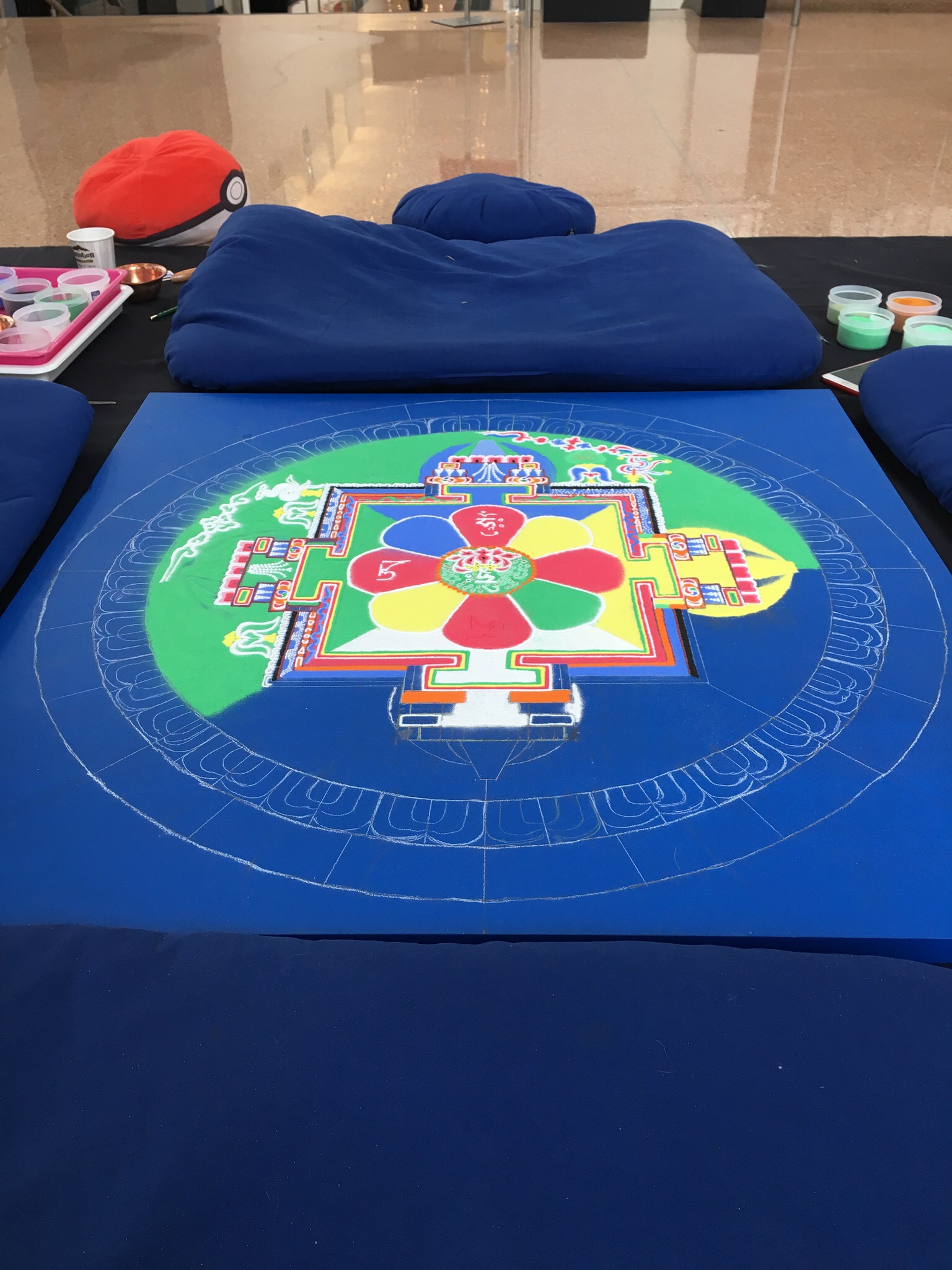 Two monks worked on the Mandala throughout. By the end of the first full day, the Mandala began to take shape. All throughout the day, visitors gathered around the Sand Mandala, from guests to the Fine Arts Center to classes of elementary school children. The Monks worked with single pointed concentration while people stood over their shoulders or watched from video screens set up in the hallway. At one time a young girl was nestled up next to a monk while he continued to work on the Mandala. When the monks took a break, they would talk with others around them, share tea, and walk up and down the hallway smiling, stretching, and relaxing. Surely in all this was love and kindness.
Two monks worked on the Mandala throughout. By the end of the first full day, the Mandala began to take shape. All throughout the day, visitors gathered around the Sand Mandala, from guests to the Fine Arts Center to classes of elementary school children. The Monks worked with single pointed concentration while people stood over their shoulders or watched from video screens set up in the hallway. At one time a young girl was nestled up next to a monk while he continued to work on the Mandala. When the monks took a break, they would talk with others around them, share tea, and walk up and down the hallway smiling, stretching, and relaxing. Surely in all this was love and kindness.
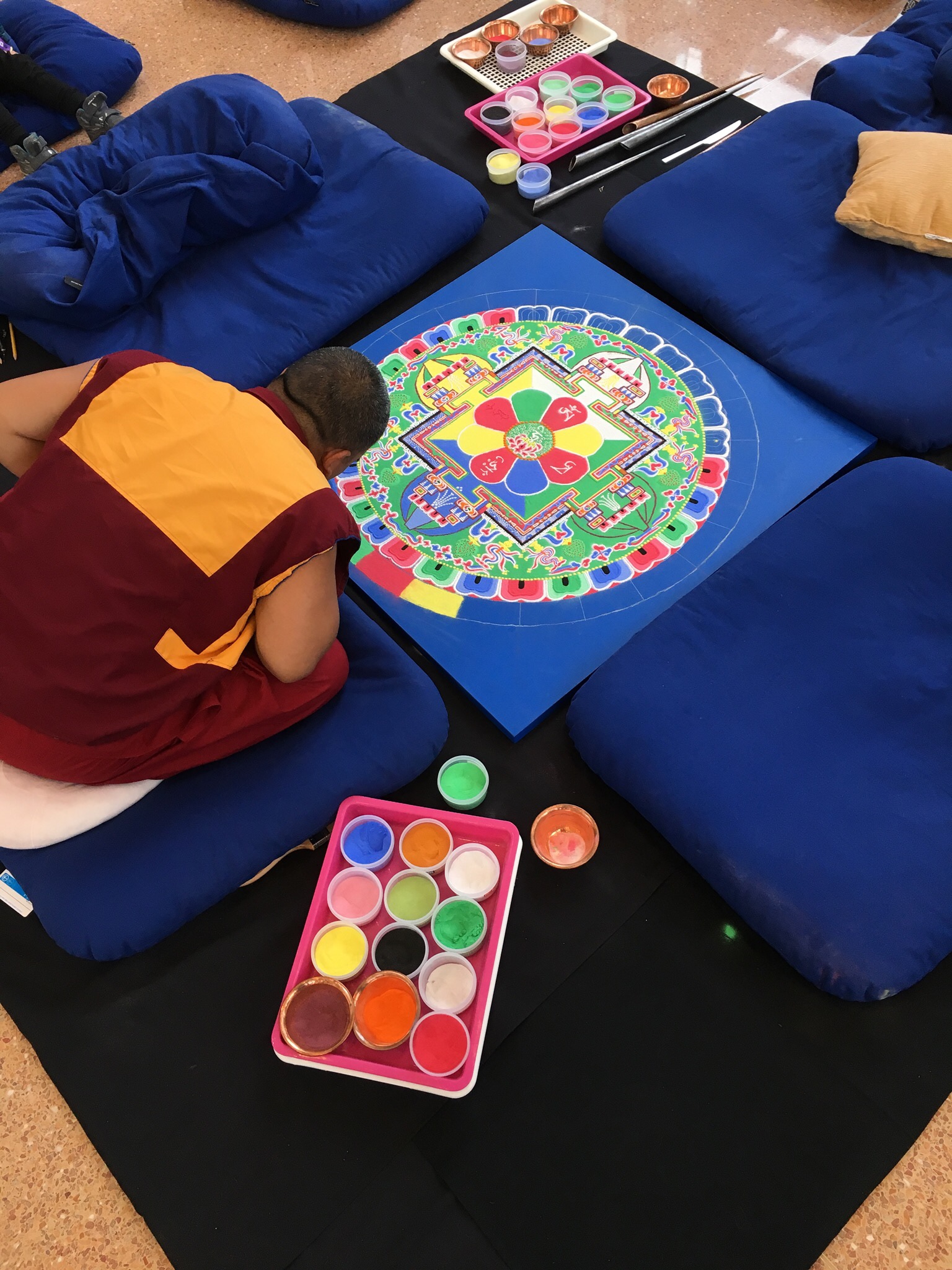 By the following day, hours into their practice, the two monks continued with the same single pointed concentration. Sitting on mats and cushions, slowly tapping out sand in intricate patterns and designs, they continued their work of compassion through their art and practice, through perseverance, through vital energy dedicated to a single task of love and kindness. Sitting alongside and watching in meditative inquiry, how could one not be moved by their practice and generosity? It filled the room and the city, as evidenced by the number of people who came to just take it in.
By the following day, hours into their practice, the two monks continued with the same single pointed concentration. Sitting on mats and cushions, slowly tapping out sand in intricate patterns and designs, they continued their work of compassion through their art and practice, through perseverance, through vital energy dedicated to a single task of love and kindness. Sitting alongside and watching in meditative inquiry, how could one not be moved by their practice and generosity? It filled the room and the city, as evidenced by the number of people who came to just take it in.
After it was completed, the Mandala was raised on a platform and surrounded by candles, Buddha statues, and flowers. Although the monks were done with their part of the creation, the effects continued to grow and spread. Visitors came to see the finished Mandala. Students around town were making plans to attend the Dissolution Ceremony. Pictures were shared on social media. The Compassion Mandala continued to spread far and wide.
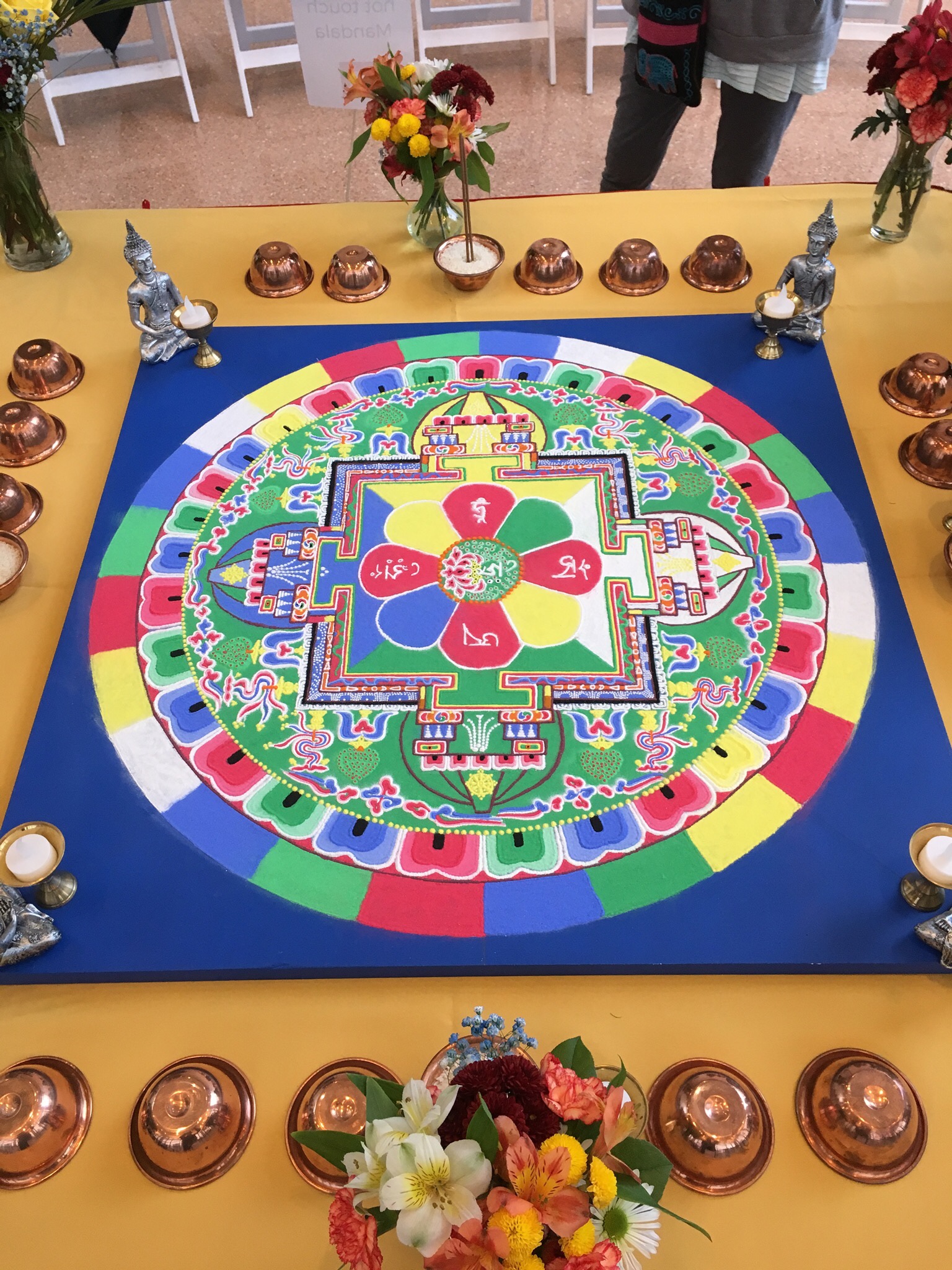
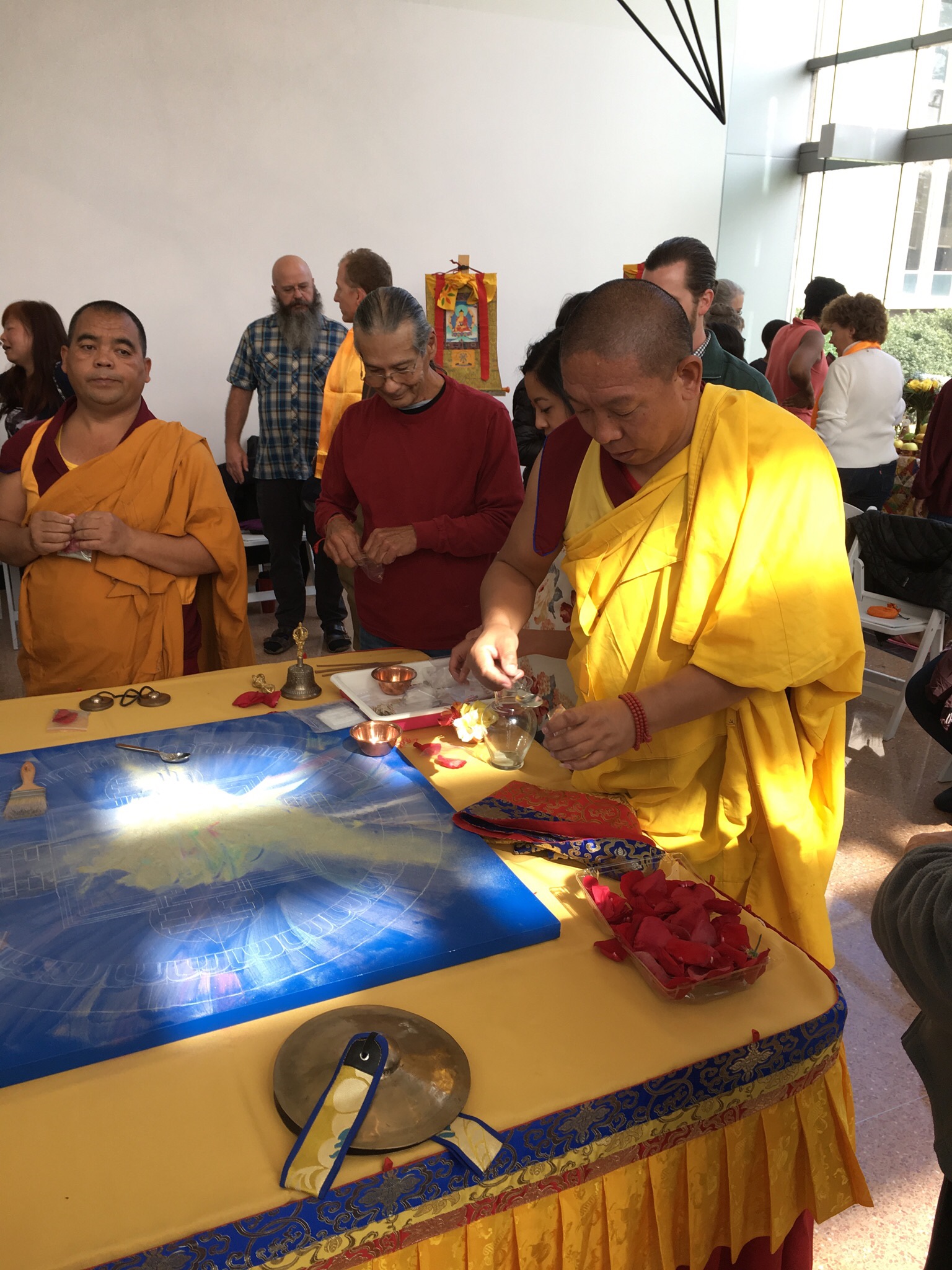 The dissolution ceremony brought people from all over the town. Some just happened to be there because they were visiting the Fine Arts Center that day. Many arrived for the ceremony itself. After chanting, prayers, and music, the monks began to sweep the sand into a pile in the center of the platform. The Sand Mandala was no more. Small scoops of sand were handed out in little bags. The rest was placed in a jar along with flowers and brought down to Monument Creek where it was spread among the ten thousand elements.
The dissolution ceremony brought people from all over the town. Some just happened to be there because they were visiting the Fine Arts Center that day. Many arrived for the ceremony itself. After chanting, prayers, and music, the monks began to sweep the sand into a pile in the center of the platform. The Sand Mandala was no more. Small scoops of sand were handed out in little bags. The rest was placed in a jar along with flowers and brought down to Monument Creek where it was spread among the ten thousand elements.
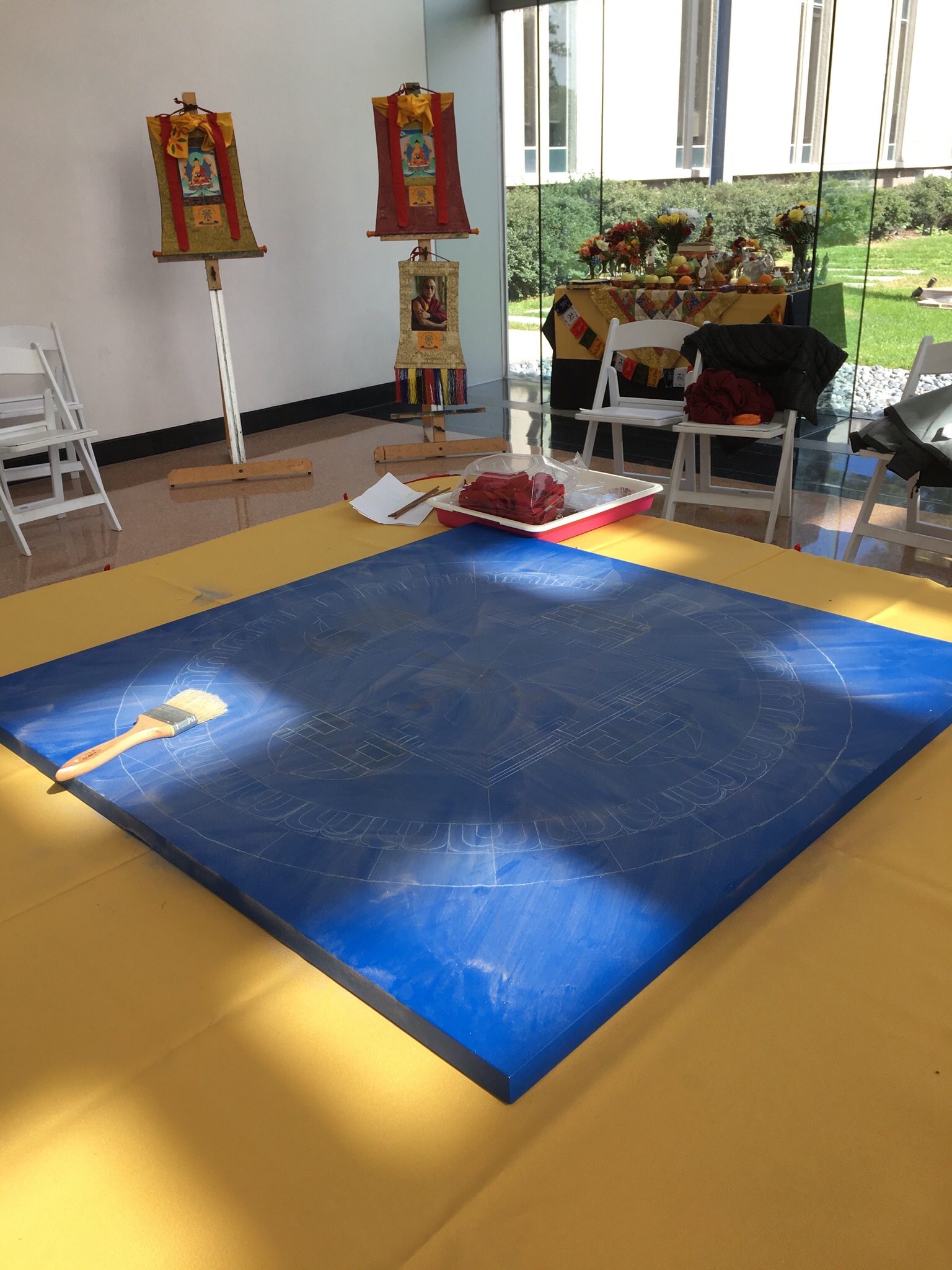
So in all of this, where was the love and kindness? The compassion? Where was the Sand Mandala?
It was in the air, the ritual, the practice. It was radiating beyond anything that can be expressed with words. It was felt deeply without knowing how it was felt. It was in the air, water, earth, and fire and in the combinations of these elements. But it was in all of these ritual and spiritual and magical things because it was in the small everyday acts of love and kindness and compassion. It was in the small child sitting next to the monk watching him tap sand onto a platform. It was in the monks’ long hours of sitting and meditation. It was people stepping aside so others could see the Mandala. It was in the hugs and smiles and hellos of old friends seeing each other again there next to the Mandala. It was in the planning, the hours of preparation, the volunteer meals, the tea being offered, and all the other ten thousand acts of kindness to make the events run smoothly.
The magic of compassion arises from the everyday mundane acts, and the everyday mundane acts are what make the magic of compassion alive and beyond words. May you find compassion, love, and kindness in your everyday life! May you be well, at ease, and happy!
With a deep bow of gratitude from Colorado Springs…
 Two monks worked on the Mandala throughout. By the end of the first full day, the Mandala began to take shape. All throughout the day, visitors gathered around the Sand Mandala, from guests to the
Two monks worked on the Mandala throughout. By the end of the first full day, the Mandala began to take shape. All throughout the day, visitors gathered around the Sand Mandala, from guests to the  By the following day, hours into their practice, the two monks continued with the same single pointed concentration. Sitting on mats and cushions, slowly tapping out sand in intricate patterns and designs, they continued their work of compassion through their art and practice, through perseverance, through vital energy dedicated to a single task of love and kindness. Sitting alongside and watching in meditative inquiry, how could one not be moved by their practice and generosity? It filled the room and the city, as evidenced by the number of people who came to just take it in.
By the following day, hours into their practice, the two monks continued with the same single pointed concentration. Sitting on mats and cushions, slowly tapping out sand in intricate patterns and designs, they continued their work of compassion through their art and practice, through perseverance, through vital energy dedicated to a single task of love and kindness. Sitting alongside and watching in meditative inquiry, how could one not be moved by their practice and generosity? It filled the room and the city, as evidenced by the number of people who came to just take it in.
 The dissolution ceremony brought people from all over the town. Some just happened to be there because they were visiting the Fine Arts Center that day. Many arrived for the ceremony itself. After chanting, prayers, and music, the monks began to sweep the sand into a pile in the center of the platform. The Sand Mandala was no more. Small scoops of sand were handed out in little bags. The rest was placed in a jar along with flowers and brought down to Monument Creek where it was spread among the ten thousand elements.
The dissolution ceremony brought people from all over the town. Some just happened to be there because they were visiting the Fine Arts Center that day. Many arrived for the ceremony itself. After chanting, prayers, and music, the monks began to sweep the sand into a pile in the center of the platform. The Sand Mandala was no more. Small scoops of sand were handed out in little bags. The rest was placed in a jar along with flowers and brought down to Monument Creek where it was spread among the ten thousand elements.
 I am starting a project on Descartes’ Meditations. More than just in the title, Descartes’ work has a deep affinity with the tradition of meditations or spiritual exercises of his time. And beyond the traditions he was familiar with, there is the larger tradition of meditation via doubt especially among the Zen schools that resonates with Descartes’ writing and practice. Although I stumbled upon these connections after I brought my Buddhist practice together with my reading of the Meditations, I am in no way the first to think this; indeed, part of the joy so far has been to read about these connections from authors across various disciplines!
I am starting a project on Descartes’ Meditations. More than just in the title, Descartes’ work has a deep affinity with the tradition of meditations or spiritual exercises of his time. And beyond the traditions he was familiar with, there is the larger tradition of meditation via doubt especially among the Zen schools that resonates with Descartes’ writing and practice. Although I stumbled upon these connections after I brought my Buddhist practice together with my reading of the Meditations, I am in no way the first to think this; indeed, part of the joy so far has been to read about these connections from authors across various disciplines!